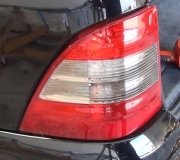The ground wires are generally bolted to the body sheet metal near that corner of the vehicle. Typically all the lights in that corner have their ground wires tied together and crimped into a single terminal that is bolted to the body. Normally I would say to follow the wires through the harness, but you're going to find they're all taped up with lots of other wires. Instead, you'll have to push stuff out of the way and look for an uninsulated terminal bolted to the body. Typical places are on the core support alongside the radiator, and on the inner fender, either near the top where the hood closes or lower under the air filter box, battery tray, or something like that.
The problem is though bolts and terminals don't just fall out. More likely you're going to find a wire that has a cut in the insulation and the wire corroded, or something hooked it and tore it. The wires could be corroded in the crimp on that terminal too. Often, if the circuit is turned on, you'll see a telltale spark when you disturb the broken connection.
If you want to test something to verify I'm as smart as I have you fooled into thinking I am, you can do that with a digital volt / ohm meter. Do you have one and know how to use it? I'm pretty sure you're going to have a 3157 bulb for the turn signal / running light. That has a flat plastic base with four wires wrapped around it. I don't know if this will reproduce correctly, but in that socket with the bulb removed, the four terminals will look like:
_____ _____
_____ _____
Two of them. Lets say the two on the left, will be tied together. Those are the ground connections, one for each filament in the bulb. One on the right is the 12 volt feed for the running light and the other right one is the 12 volt feed for the turn signal. Turn on the running / tail lights, then test for voltage on these four terminals. You should have 12 volts on just one of them. The other three are supposed to have 0 volts, but in this case I think you're going to find something in the order of four to six volts feeding from the other side. I could be wrong on that, so don't get wrapped around the axle if you find 0 volts.
The point is, in my sad story lets say you find 12 volts on one of the right terminals. That means the two on the left are supposed to go to ground, and you can test that with the ohm meter. Switch it to the lowest ohms scale, put one meter probe on the battery's negative post, or a paint-free point on the body or a bolt head, and the other probe on those two terminals on the left. You're supposed to find 0.0 ohms but due to the normal resistance in the wires and in the meter leads, two to maybe six ohms is typical. If we're on the right track, you're going to find an "over-range" indication meaning there's an open circuit and the infinite resistance is more than the meter will measure on that scale. Now it's just a matter of following those ground wires to the break.
Thursday, May 28th, 2015 AT 8:47 PM


